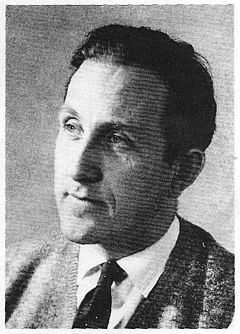Wilhelm Cornides


Wilhelm Cornides (July 20, 1920 – July 15, 1966) was a Wehrmacht sergeant in World War II known as the author of the Cornides Report, a report concerning his first hand experience of the extermination of Jews at the Belzec concentration camp. He was the founder of Europa-Archiv (renamed Internationale Politik in 1995), the first post-war publication in Occupied Germany in Dec. 1946. In 1955 he was instrumental along with Theodor Steltzer, Minister-President of Schleswig Holstein and former member of the Kreisau Circle with founding the German Council on Foreign Relations, known by the acronym DGAP, for its German spelling (Deutsche Gesellschaft für Auswärtige Politik). Cornides was a member of the Oldenbourg family, owners of R. Oldenbourg Verlag (publishers). A German publishing house started in 1858 by Rudolf Oldenbourg.
Holocaust witness
On August 30, 1942 Cornides, was in the Rzeszów rail station, on his way to Chełm by train. In his journal he wrote that a railway policeman had told him that ‘a marble plaque with golden letters will be erected on 1 September, because then the city will be "Judenfrei" (free of Jews). The policeman also told him that trains filled with Jews "pass almost daily through the shunting yards, are dispatched immediately on their way, and return swept clean, most often the same evening." Some 6,000 Jews from Jarosław, were recently killed in one day."
Cornides took a regular passenger train from Rzeszów to Chełm, he arrived in Rawa Ruska on August 31, and made further entries in his journal;
"At ten minutes past noon I saw a transport train run into the station. On the roof and running boards sat guards with rifles. One could see from a distance that the cars were jammed full of people. I turned and walked along the whole train: it consisted of 35 cattle cars and one passenger car. In each of the cars there were at least 60 Jews (in the case of the enlisted men's or prisoner transports these wagons would hold 40 men; however, the benches had been removed and one could see that those who were locked in here had to stand pressed together). Some of the doors were opened a crack, the windows criss-crossed with barbed wire. Among the locked-in people there were a few men and most of those were old; everything else was women, girls and children. Many children crowded at the windows and the narrow door openings. The youngest were surely not more than two years old.

As soon as the train halted, the Jews attempted to pass out bottles in order to get water. The train, however, was surrounded by SS guards, so that no one could come near. At that moment a train arrived from the direction of Jarosław; the travellers streamed toward the exit without bothering about the transport. A few Jews who were busy loading a car for the armed forces waved their caps to the locked-in people.
.jpg)
I talked to a policeman on duty at the railway station. Upon my question as to where the Jews actually came from, he answered: "Those are probably the last ones from Lwów. That has been going on now for three weeks uninterruptedly. In Jarosław they only let eight remain, no one knows why." I asked: "How far are they going?" Then he said: "To Belzec." "And then?" "Poison." I asked: "Gas?" He shrugged his shoulders. Then he said only: "At the beginning they always shot them, I believe."[1][2]
See also
References
- ↑ Final Journey The fate of the Jews in Nazi Europe by Martin Gilbert Publisher: New York, New York Mayflower Books (January 1, 1979) ASIN: B0027U6TUQ
- ↑ Peter Longerich,Die Ermordung der europäischen Juden. Eine umfassende Dokumentation des Holocaust,Piper, Munich, 1989 (contains reproduction of Cornides notes).
External links
- Cornides report
- Cornides Notes
- Deportations to Belzec Arad, pp. 383-389
- DGAP
- International Politik English version
|